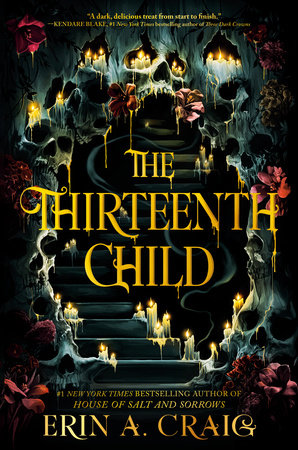
The Thirteenth Child is finally here! This latest fantasy saga from author Erin A. Craig is based on the Grimm Brothers’ dark fairytale “Godfather Death.” We asked Erin to take us behind the scenes and share her process in crafting such an iconic character as Death.
“The Thirteenth Child: Bringing Death to Life”
Erin A. Craig
If you think through the lexicon of humanity’s stories—whether folklore, fables, epic adventures, giant literary tomes, or even last summer’s box-office smashes—there is one character archetype who appears over and over, popping up with as much certainty as the grave: Death.
We’ve seen him—or her!—in any number of ways: an angular wraith in a bespoke suit, a wafty figure clad in flowing robes and blue flames, a literal skeleton, animated and charged with powers beyond mortal comprehension. It’s fascinating to examine the many ways people throughout the ages have portrayed Death.
In the Grimm Brothers’ fairy tale “Godfather Death,” he comes to a set of panicked parents and offers to take on the role of benefactor for their unborn child. At face value, the idea seems absurd. Why would anyone hand over their baby to Death? The parents are desperate, but Death? Really? What were Jacob and Wilhem thinking? Who was editing their stuff?
As I began to outline, I spent a lot of time mulling over what my take on Death—for this retelling’s purposes, Merrick, the Dreaded End—would be. It would have been easy to highlight his absolute power and authority, his unflinching equalization. No matter who you are or how important you become in this life, Death comes for all.
But one thing kept poking at me, demanding to be noticed. Yes, the parents gave away their baby to Death, but only after he came to save them in the first place. Death wanted this child. He sought out and volunteered to take on the responsibility of this new life.
That one action was a key, unlocking Merrick’s character and backstory for me. I began to imagine his days, being present at a hundred final moments, a hundred thousand million, over and over, without pause, without end. It made sense he’d long for a beginning, to witness how a life could grow and expand. So saturated by sorrow, it’s only natural he’d be curious about love and joy.
Merrick does his best, dreaming of all the ways he’ll take care of Hazel, imagining her childhood through rosy, sun-dappled filters. Caught in these dreams, he forgets that mortals experience time much differently than the divine. He doesn’t understand the full complexities of a human heart, the need for companionship and familial bonds, the desire for autonomy and free will. He overcompensates, showering Hazel with gifts and treasures, laying out an idealized path for her life without ever stopping to ask what she thinks of any of it. So caught up in creating the perfect moment, in being a perfect father figure, he doesn’t see the girl in front of him for who she truly is. It takes him decades to learn her favorite flavor of cake.
But eventually he does.
Merrick’s bumbling earnestness caught my heart. Watching him try and fail and try even harder was endearing. He loves Hazel—always present tense, never past—with such a fierce devotion that I couldn’t help but reflect on my own relationships, as a mother, wife, daughter, sister, friend, wondering what I would do in his situation, trying to imagine how I’d respond. So much of this book has remained and lingered in my mind, long after I typed the final “The End.” I’d no idea that when I set out to write about Death, I’d be creating one of my most human characters.


